#an American auction in paris
Photo



The fashion nerd in me is utterly thrilled by Felicity’s summer dress. This style of lightweight white cotton dress was eventually referred to as a chemise à la reine, after Marie Antoinette was painted (and immediately hated for) wearing one.

This style only really became popular for adults in the 1780s, but in the 1770s, it was popular summer-time wear for girls.
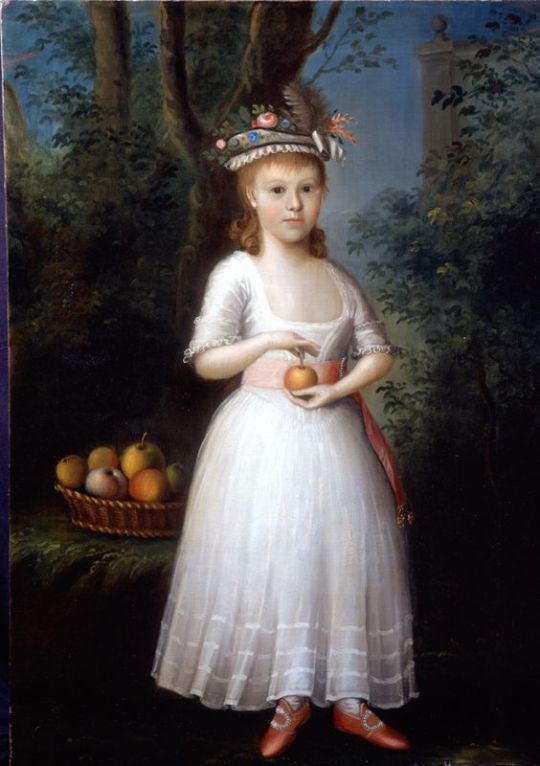
There’s not a whole lot to say about Elizabeth’s dress, it’s again pretty accurate and appropriate for her social status.
The straw hats are not simply straw hats. The proper name for that style is bergère, or shepherdess. They were pretty essential outdoor wear for proper ladies who wanted to protect their fine pale complexions.

(Kerry Taylor Auctions)

(The Victoria & Albert Museum)
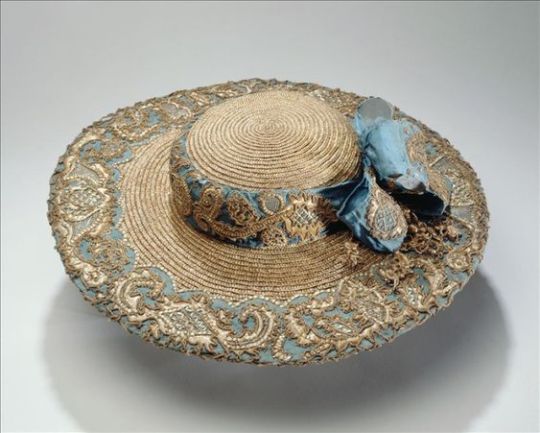
(Musée Galliera de la Mode de la Ville de Paris)
Finally, I kind of feel the need to address what’s the elephant in the room when it comes to Felicity:

Everyone was acting all horrified and outraged by this, but, well.... have I got news for you about middle-class white families in Virginia in 1774. It would be very inaccurate for them to not have slaves.
If we want to get technical, Felicity herself never actually owned slaves. Her father owned a couple of slaves, and her grandfather owned a plantation. When her grandfather died, the plantation would have gone to her father, and then down to her little brother, William. Felicity likely would have grown up to marry a man who owned slaves, but she still wouldn’t own them outright herself. All that being said, there were special no-male-heir circumstances in which women could inherit property, and there absolutely were woman slave-owners out there.
Slavery is a part of American history and honestly it does us more of a disservice if we try to cover it up. The fact that Felicity’s family owns slaves is a great chance to teach kids about the big, messy questions of history. Kids are smart and capable of understanding complex historical issues. They deserve to know this kind of shit.
547 notes
·
View notes
Note
Hey there, it's the anon who asked about Maria Reynolds! I realized in hindsight (read: two seconds after I sent the ask lmao) that I got her mixed up with Maria Cosway, and then I realized that I don't know crap about her either. Reading past posts you seem to mostly cover stuff about Hamilton and the people surrounding him, and also Maria Cosway isn't American lol, but I hope you don't mind me at least asking anyway? Sorry for rambling it's cool if you don't answer
hey welcome back! don't worry, you're not the first nor the last person to do that lol. and don't worry! europeans are welcome here, so maria cosway is fair game for asking about. however, apologies for asking questions aren't so i hate you (jk ily <3) now i won't be able to go into as much detail because im not drawing from much of my own personal knowledge, but my internet sources will be linked!

Source: The Judgment of Korah, Dathan and Abriam by Maria Louisa Catherine Cecilia Hadfield Cosway
Maria Louisa Catherine Cecilia Hadfield Cosway was the first child of two hotel owners in Florence, Italy. As a young girl in a convent, she showed proficient artistic talent in both drawing and music. She was educated by Johann Zoffany and introduced her to other European artists.
She began painting by copying other works when she began to get recognition, allowing her to travel Italy. After her father's passing, she moved to London in 1779 and became well connected. One such connection was with Angelica Kauffman Church (not the same as Angelica Schuyler Church, though she was friends with her two) who was also a female painter.
Maria was introduced to Richard Cosway in London, and they were married in January 1781 for primarily financial reasons. The couple were within the most fashionable circles of the time. In 1786, the Cosways went to Paris where they met Thomas Jefferson. Maria and Jefferson became friends who flirted an excessive amount, and I found a really interesting article on that here.
Unfortunately, her husband was a grade-A asshole who wouldn't sell her works and stunted her artistic growth. I'm an artist, and I can tell you, a few months off can really do a lot of damage to your muscle memory and suddenly everything you put on paper looks like absolute shit, so I feel for her.
Maria had her only daughter, Louisa Paolina Angelica, in May 1790 but her health suffered afterwards. She went to Italy to recoup and returned to London in 1794. In 1796, her daughter tragically died.
Maria coped by turning to religion, Catholicism to be specifically (been there too, she just like me fr). However, on the plus side, she got her prints published by Rudolph Ackermann and made etchings of paintings at the Louvre which had been stolen during the Napoleonic Wars. She actually knew the Bonapartes personally and their patronage allowed her to open a girls' school at Lyons in 1803, which is so badass. She would later open another school for girls in Lodi in 1812.
Her husband died in 1821, and she sold his work at auction. She used some of the profit from these sales to fund her school in Lodi which is so fucking metal. She was actually made a baroness by the Austrian Emperor and Empress after they visited her school. That's also fucking metal.
She lived the rest of her life in Lodi where she died in 1838 near her school. In conclusion, Maria Cosway was more badass than I realized, and I think she's absolutely lovely. RAHHH WOMEN!!!
I hope this has helped. Again, sorry I haven't been able to go as in-depth, but I don't know Maria like that. I'm gonna give you extra sources just because I love you so much. I hope you can find a jumping off point!! European painters are always interesting, especially if they're badass, metal women who kick names and take ass, so I encourage you to do more research!!!
Sources: Maria Cosway- Royal Academy of Arts
Royal Collection Trust- Maria Cosway Collection (this has her art!!)
American Heritage- Thomas Jefferson and Maria Cosway (this was quoted in the post!)
Yale Center for British Art- Maria Cosway Was a Part of England's First Celebrity Art Couple
#history#maria cosway#maria hadfield cosway#european history#italian history#art history#women's history#18th century#1700s#1800s#19th century#thomas jefferson#angelica schuyler#angelica schuyler church#asks
14 notes
·
View notes
Text

Picasso Masterpiece 'Femme à la montre' Sells for $139 Million at Auction
A Picasso masterpiece entitled “Femme à la montre” fetched more than $139 million on Wednesday, becoming the second most valuable work by the artist ever sold at auction.
The 1932 oil painting took center-stage at a two-day event at Sotheby’s in New York, at the sale of late philanthropist Emily Fisher Landau’s private collection.
The piece, which measures 51¼ x 38 inches (130 x 96.5 centimeters), depicts Picasso’s lover and “golden muse” Marie-Thérèse Walter, who featured in many of his portraits.
According to the auction house, the portrait is from one of the most prolific years of the Spanish artist’s career, which was the subject of an entire exhibition organized by the Musée Picasso in Paris and London’s Tate Modern in 2018.
In a statement announcing the sale in September, Julian Dawes, Sotheby’s head of Impressionist & Modern Art for the Americas, said: “Picasso’s ‘Femme à la Montre’ is a masterpiece by every measure. Painted in 1932 — Picasso’s ‘annus mirabilis’ — it is full of joyful, passionate abandon yet at the same time it is utterly considered and resolved. Its bold primary colors sing from the five-foot-tall-canvas.”
Picasso first met Walter in Paris in 1927 when she was 17 years old and he was still married to his first wife, Olga Khokhlova, a Russian-Ukrainian ballet dancer. Walter would become the inspiration for some of his most sought-after canvases, drawings and sculptures.
As time went on, Picasso found it increasingly difficult to hide his feelings for Walter from his work — something that became clear during his first large-scale retrospective and finally ended his marriage.
The artist painted “Femme à la montre” in August 1932, soon after the retrospective at the Galerie Georges Petit in Paris ended.
According to Sotheby’s, “the sense of release from keeping secrets about his affair seem to have spilled out onto this extraordinary canvas, in which he gives full painterly rein to new-found freedoms, drenching the painting in strong primary colors and beautiful forms, while at the same time paying careful attention to every small detail, creating a composition that is both intensely complex and deeply harmonious.”
Picasso died in 1973, and Walter in 1977.
The painting is one of about 120 from the collection of Fisher Landau, a world renowned contemporary art collector who died earlier this year aged 102, according to The Art Newspaper.
The two-part sale, which concludes Thursday, also includes works by Mark Rothko, Andy Warhol, Willem de Kooning and Georgia O’Keeffe. The collection is expected to sell for over $400 million overall. Other big-ticket items auctioned on Wednesday included one of Jasper Johns’ iconic American flag paintings, which went for $41 million, and an Ed Ruscha artwork — an oil painting emblazoned with the word “Boss” — that fetched more than $39.4 million.
Fisher Landau began seriously collecting after receiving an insurance payout following an armed robbery of her jewelry at her New York home in 1969.
In an interview for an exhibition catalog, quoted in the Sotheby’s statement, she said of the episode: “Even though Lloyds of London paid up, there was no way to replace that collection. It was so beautiful. And they got it in one fell swoop…. I was devastated. But I decided that I didn’t want the jewelry any more. I now had seed money for a collection.”
Last year, Picasso’s most curious painting of Walter, in which she appears as a tentacled sea creature, sold for $67.5 million at Sotheby’s in New York.
Picasso’s portraits of Walter have become highly sought-after, with his other 1932 works “Femme assise près d’une fenêtre (Marie-Thérèse),” selling for $103.41 million in 2021, and “Nude, Green Leaves and Bust,” selling for $106.5 million in 2010.
In May 2015, Picasso’s “Les femmes d’Alger (Version “O”) sold at Christie’s in New York for $179.4 million — at that time, the highest price ever paid for a work of art at auction.
By Lianne Kolirin.

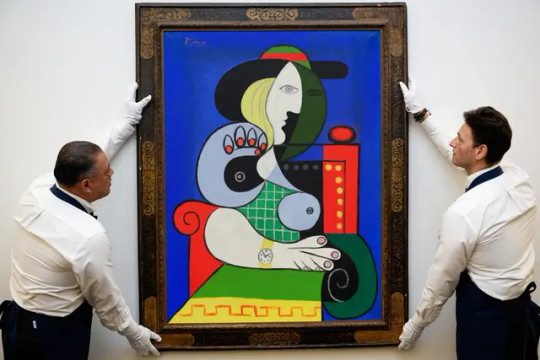
Pablo Picasso
Femme à la montre
Signed Picasso (upper left); inscribed Boisgeloup and dated 17 Août XXXII. (on the stretcher).
oil on canvas.
Executed on 17 August 1932.
51 ⅛ by 38 ⅛ in. 130 by 97 cm.
#Pablo Picasso#Picasso Masterpiece 'Femme à la montre' Sells for $139 Million at Auction#Pablo Picasso Femme à la montre 1932#spanish artist#painter#painting#oil on canvas#art#artist#art work#art world#art news
21 notes
·
View notes
Text
THIS DAY IN GAY HISTORY
based on: The White Crane Institute's 'Gay Wisdom', Gay Birthdays, Gay For Today, Famous GLBT, glbt-Gay Encylopedia, Today in Gay History, Wikipedia, and more … January 5

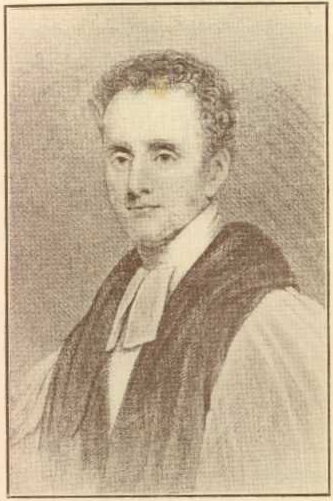
1773 – Richard Heber (d.1833) was an English book-collector.
A taste for book collecting was developed in him in childhood. As an undergraduate, he began to collect a purely classical library, but his taste broadening, he became interested in early English drama and literature, and began his wonderful collection of rare books in these departments. Succeeding on the death of his father in 1804 to large estates in Yorkshire and Shropshire, which he considerably augmented, he forthwith devoted himself to the purchase of rare books. Heber was one of the 18 founders in 1812 of the Roxburghe Club of bibliophiles.
He possessed extensive landed property in Shropshire and Yorkshire, and was High Sheriff of the former county in 1821, was Member of Parliament (MP) for Oxford University from 1821 to 1826, and in 1822 was made a D.C.L. of that University. He was one of the founders of the Athenaeum Club, London.After ransacking England for books, Heber travelled extensively on the Continent, purchasing everywhere, and leaving large depots of books in Paris, Antwerp, Brussels, Ghent, and elsewhere in the Netherlands and Germany. At booksales he sometimes purchased single volumes, sometimes whole libraries. Sir Walter Scott classed Heber's library as "superior to all others in the world." He did not confine himself to the purchase of a single copy of a work which took his fancy. "No gentleman," he remarked, "can be without three copies of a book, one for show, one for use, and one for borrowers." To such a size did his library grow that it overran eight houses, some in England, some on the Continent.
In 1826 he and Charles Henry Hartshorne, a friend he had made through the Roxburghe Club, encountered gossip and innuendo over the nature of their relationship. John Bull magazine hinted in two of its issues that it was homosexual. Heber abruptly left the country; Hartshorne sued John Bull successfully in the courts.
At his death his collection in England was estimated by at 105,000 volumes, exclusive of many thousands on the Continent, the whole having cost more than £180,000. This immense library was disposed of by auction after the owner's death, the sale lasting 216 days and realizing more than £60,000.
After he died the well-founded gossip that he had been homosexual resurfaced.


1907 – Rod Riffler, born Rudolf Ungar, (d.1941) was a Croatian modern dance teacher, choreographer and owner of a dance school in Zagreb, who was killed during the Holocaust.
Riffler was born in Osijek to a Jewish parents, Makso and Ilka (née Lang) Ungar. His father was a merchant born in Osijek. Riffler was raised with two siters, Marie Louise and Marija, and younger brother, Rafael. When he moved from Osijek to Zagreb, Riffler opened a dance school and was one of the best teachers of modern dance at the time.
Riffler was mentor and teacher of Lea Deutsch, the well-known Croatian Jewish child actress. He was also a close friend of Deutsch's mother, Ivka.
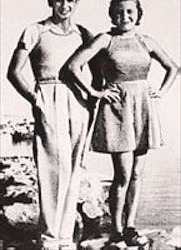
Riffler was homosexual. In 1941, when the Ustaše (Croatian Fascists) found out that he was a Jew and homosexual, Riffler was arrested and deported to Jasenovac concentration camp. Riffler died from hunger in the Jasenovac concentration camp. He was 34 years old.
In 2010 Croatian director Branko Ivanda made a film "Lea i Darija - Dječje carstvo" (Lea and Darija - Children's Empire), about the tragic destiny of Lea Deutsch, who died while being shipped to Auscwitz. Rod Riffler was portrayed in the movie by Croatian actor Radovan Ruždjak.


1931 – Alvin Ailey, Jr. (d.1989) was an American choreographer and activist who founded the Alvin Ailey American Dance Theater in New York. Ailey is credited with popularizing modern dance and revolutionizing African-American participation in 20th century concert dance. His company gained the nickname "Cultural Ambassador to the World" because of its extensive international touring. Ailey's choreographic masterpiece Revelations is believed to be the best-known and most often seen modern dance performance.
Ailey was born to his 17-year-old mother, Lula Elizabeth Ailey, in Rogers, Texas. His father abandoned the family when Alvin was only 6 months old. Like many African-Americans living in Texas during the Great Depression, Ailey and his mother moved very often and she had a hard time finding work. Ailey grew up during a time of racial segregation and rumors of violence and lynchings against African-Americans. When Ailey was five, his 22-year-old mother was raped by a group of white men, leaving him afraid of whites. Early experiences in the Southern Baptist church and jook joints instilled in him a fierce sense of black pride that would later figure prominently in Ailey's signature works.
In the fall of 1942, Ailey's mother, like many African Americans, migrated to Los Angeles, California where she had heard there was lucrative work supporting the war effort. Ailey joined his mother later by train, having stayed behind in Texas to finish out the school year. Ailey's first junior high school in California was located in a primarily white school district. As one of the only black students, Ailey felt out of place because of his fear of whites, so the Aileys moved to a predominantly black school district.
Ailey did not become serious about dance until in 1949 his school friend Carmen De Lavallade introduced him to the Hollywood studio of Lester Horton. Horton would prove to be Ailey's major influence, becoming a mentor and giving him both a technique and a foundation with which to grow artistically.
When Horton died in November 1953 the tragedy left the company without an artistic director. The company had outstanding contracts that required and desired new works. When no one else stepped forward, Ailey assumed the role of artistic director. Despite his youth and lack of experience (Ailey was only twenty-two and had choreographed only one dance in a workshop) he began choreographing, directing scene and costume designs, and running rehearsal. Not finding another mentor, he began creating works of his own.
Ailey formed his own group, Alvin Ailey American Dance Theater, in 1958. The group presented its inaugural concert on March 30, 1958. Notable early work included Blues Suite, a piece deriving from blues songs. Ailey's choreography was a dynamic and vibrant mix growing out of his previous training in ballet, modern dance, jazz, and African dance techniques. Ailey insisted upon a complete theatrical experience, including costumes, lighting, and make-up. A work of intense emotional appeal expressing the pain and anger of African Americans, Blues Suite was an instant success and defined Ailey's style.
For his signature work, Revelations, Ailey drew upon his "blood memories" of Texas, the blues, spirituals, and gospel. These forces resulted in the creation of his most popular and critically acclaimed work. Ailey originally intended the dance to be the second part of a larger, evening-length survey of African-American music which he began with Blues Suite.
Ailey was openly gay and is one of the most prominent gay Black men in American history. According to Black gay activist Keith Boykin, this is rarely acknowledged in the Black community due to the stigma surrounding homosexuality. For a time during the 1950s, Ailey was romantically linked with political activist David McReynolds. Ailey died in 1989 at the age of 58. To spare his mother the social stigma of his death from AIDS, he asked his doctor to announce that he had died of terminal blood dyscrasia


1942 – The Spanish novelist Terenci Moix had a fascination for the ordinary combined with beautifully wrought language, and a love of good living, honed by lonely hours struggling for literary perfection. His Onades sobre una roca deserta, (Waves On A Desolate Rock) won the 1968 Pla prize.
The following year, he published El dia que va morir Marilyn (The Day That Marilyn Died), which became the talisman-book of his generation. This famous novel follows two Barcelona families from before the Spanish civil war to the new freedoms of the 1960s.
Moix was born to a lower middle-class family in Barcelona's old city, and christened Ramon. In the bitter years after the civil war, he grew up in the Plaza del Peso de la Paja (straw-weighing square). El peso de la paja also means the "weight of wanking" – the sort of double entendre that Moix adored – and, in the 1990s, became the title of his three-volume autobiography.
He left school at 14, and fled from his parents' rows to live for several years in Paris, London and Rome. Abroad, he met 1960s pop culture, which reaffirmed the value of the world of films he had escaped into as a child. He became, too, a man of formidable knowledge and culture – a linguist, an opera-lover and an Egyptologist.
Moix chose early to live his life as freely as possible. He returned to Barcelona in the mid-1960s to become openly (and illegally) homosexual, irreverently exhibitionist, scandalous and obscenely witty. Some say he named himself Terenci after the young Terence Stamp.
In 1986, he won the Planeta prize with No digas que fue un sueño (Don't Say It Was A Dream), a reworking of the story of Antony and Cleopatra. This sold more than a million copies, and brought him mass popularity. It is a book of lyrical, rich language, peppered with mordant darts of irony and laughing vulgarity.
Four more novels on ancient Egypt followed, culminating in El arpista ciego (The Blind Harpist, 2002). He was wont to say, with a rich camp chuckle, that he had been left by seven lovers, so took refuge in frequent visits to Egypt – first in the 1960s – and a vast collection of videos. Egypt and films were the loves that never betrayed him.
Moix lived life on his own terms. Transgressing society's norms, he found that masses of people ended up loving him for his freedom and integrity. His best books are landmarks in modern Spanish literature.
He died in 2003 aged 61 from emphysema.


1943 – On this date the famed Dutch soccer referee Ignace Van Swieten was born (d. 2005), He was born in a Japanese POW camp near Semarang in Indonesia, a Dutch colony at the time.
Van Swieten was openly Gay at a time when it was not accepted in professional sports. Hell it's still tough. According to a 2009 poll conducted by the Dutch football magazine, Magazine Voetbal International, 33% of professional football players in the Dutch league expressed the notion that if a footballer came out of the closet, he wouldn't have a life anymore. Twenty-five percent believe that homosexuality will always be a taboo. Sixty percent feel that there is no place for homosexuals in Dutch football. Only eleven players said that they do not consider it a taboo anymore.
Van Swieten received a lot of hatred from players and fans alike, including an attack with a hammer, but is now considered a great figure in Dutch Football and a valued teacher to other players. He was also a teacher at the KNVB Academy, the Educational Department of the Royal Netherlands Football Association. He died of lung disease in 2005.


1965 – Robert Beachy, born in Aibonito, Puerto Rico, is associate professor of history at Underwood International College at Yonsei University in Seoul, South Korea. He formerly taught at Goucher College in Baltimore, Maryland. He received his Ph.D. from the University of Chicago in 1998. Beachy specializes in the intellectual and cultural history of Germany and Europe, and is known for his work on the history of sexuality in the Weimar Republic, under the Nazis, and in Germany after the Second World War.
In 2009, Beachy was named a fellow of the John Simon Guggenheim Memorial Foundation for his research on homosexuality in Nazi Germany. Beachy's work also has received support from the Huntington Library, the National Humanities Center, the Max Planck Institute for History, the Herzog August Bibliothek in Wolfenbüttel, the German Academic Exchange Service (DAAD) and the American Philosophical Society.
In 2015, his work "Gay Berlin: Birthplace of a Modern Identity" was named a Stonewall Honor Book in Non-Fiction by the American Library Association.


1984 – Ryan O'Meara, born in Houston, Texas, is an American ice dancer. With partner Jamie Silverstein, he is a 2006 Olympian. Following his retirement from competitive skating, he began working full-time as a coach and an interior designer.
O'Meara competed on the novice and junior levels with Melissa Ralph and Lia Nitake, having some success with them both. He won four straight medals at the U.S. Championships on the novice and junior levels between 1999 and 2002, two with Ralph and two with Nitake. He competed with Lydia Manon from 2003 to 2005. With Manon, he won the bronze medal at the 2005 U.S. Championships and at the 2005 Four Continents, following which Manon decided to end the partnership.
He began training with Jamie Silverstein, a former World Junior Champion with Justin Pekarek, in April 2005. They were coached by Igor Shpilband and Marina Zueva in Canton, Michigan. Silverstein and O'Meara had sudden success. They were sent as a host entry to the 2005 Skate America, their first international competition together as a team, and placed 5th.
They won the bronze medal at the 2006 U.S. Championships, which qualified them for the 2006 Winter Olympics and the 2006 Four Continents Championships. They competed at the Four Continents and placed 6th.
At the Olympics, they placed 18th in the compulsory dance, 16th in the original dance, and 18th in the free dance, placing 16th overall out of 23 teams. They chose not to compete at the 2006 World Championships. U.S. pewter medalists Morgan Matthews and Maxim Zavozin were sent in their place.
In the spring of 2006, Silverstein and O'Meara announced they would be taking time off from competitive skating. Their partnership ended soon after and O'Meara retired from competitive skating.
O'Meara works as a coach. He owns an interior design business called "Palavela Home", which is named after the Palavela, the venue for the figure skating competition at the Olympics. O'Meara is openly gay

1988 – Raleigh, North Carolina enacts a gay rights ordinance. Raleigh is the hometown of the famous homophobe Jesse Helms.


9 notes
·
View notes
Photo
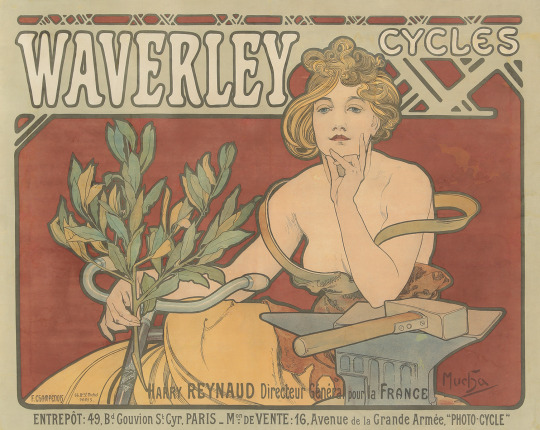
Alphonse Maria Mucha (1860-1939) - Waverley Cycles
Vintage poster. Printed in 1898 by F. Champenois, Paris.
32.75 x 42.1 inches, 83.2 x 107 cm. Estimate: US$17,000-20,000.
Sold Poster Auctions Intl, New York, 12 July 2022 for US$26,400 incl B.P
Produced to promote the American-made Waverley cycles to the French market.
61 notes
·
View notes
Text
Edgar Allan Poe (1809–1849) changed residences about once a year throughout his life. Driven by a desire for literary success and the pressures of supporting his family, Poe sought work in American magazines, living in the cities that produced them. Scott Peeples chronicles Poe’s rootless life in the cities, neighborhoods, and rooms where he lived and worked, exploring how each new place left its enduring mark on the writer and his craft.
Poe wrote short stories, poems, journalism, and editorials with urban readers in mind. He witnessed urban slavery up close, living and working within a few blocks of slave jails and auction houses in Richmond and among enslaved workers in Baltimore. In Philadelphia, he saw an expanding city struggling to contain its own violent propensities. At a time when suburbs were just beginning to offer an alternative to crowded city dwellings, he tried living cheaply on the then-rural Upper West Side of Manhattan, and later in what is now the Bronx. Poe’s urban mysteries and claustrophobic tales of troubled minds and abused bodies reflect his experiences living among the soldiers, slaves, and immigrants of the American city.
Featuring evocative photographs by Michelle Van Parys, The Man of the Crowd challenges the popular conception of Poe as an isolated artist living in a world of his own imagination, detached from his physical surroundings. The Poe who emerges here is a man whose outlook and career were shaped by the cities where he lived, longing for a stable home.
3 notes
·
View notes
Text

Janet Scudder
(American, 1869-1940)
Parisian Street Scene, signed lower right "Janet Scudder", Paris colourman stamp verso, oil on canvas
From Terre Haute, Indiana became a very important sculptor.
Brunk Auctions
8 notes
·
View notes
Text

Tankiste Loadout Display
Shown here is the Great War French Tank Crewman loadout displayed in its entirety. This display photo includes both regulation items as well as common items a Veteran tankiste would reasonably have within the time frame of 1918. With the completion of this writeup I hope you have gained newfound knowledge and respect for the soldiers of the Artillerie Spéciale who did not have the privilege we have to wear their uniform in a purely educational and peaceful capacity. While reenacting does not give us the attached, constant, and profound social impact necessary to truly understand the citizen soldier's feelings of the time, what we can do as preservers of history is get as close as possible to this feeling through authenticity. Part of this is, of course, performed through understanding the history of their uniform and the 'why' behind its appearance. It is especially important in regards to the AS as their uniform would be developed at the frontline by the soldiers themselves. Thus, wearing the uniform as a reenactor provides greater insight into why the soldiers modified their kit more than any time period photo could. By far the best part of the hobby is reading a memoir or account of a tankiste complaining about a certain aspect of the uniform, and wearing the uniform and agreeing with their complaint 100 years later.
It honestly feels very cathartic to be at a stopping point in this impression that I feel is sufficient enough to both respect and teach the history of the AS with others. This kit is the product of years of pure research, long nights translating French documents, the stress of historical auctions, trial and error, dumb luck, consultation with experts in the field, and general all around effort in finding the right things to acquire. As a reenactor who specializes in the French tank corps of the Great War, I am glad to have shared this interest with you. Well until next time!
♠ ♥ ♦ ♣
I believe it would be appropriate to end this deep dive into AS history with the words of General Estienne and his thoughts on the American Tank Corps from the May 1921 letter:
"General Estienne (who organized the Tank-Corps)
Inspector of the Tank-Corps
4 bis Boulevard des Invalides. Paris 26th - May 1921 -
"Madamoiselle;
I am much pleased to give you my view as a soldier of what we owe to the American help. Without this help, I don't believe Marichal Foch would have been able to effect the wonderful manoeuvre by which, in 4 months, he forced the enemy to a capitulation, unequalled since that of Carthage. From a personal point of view, as commander of an artillery attack in Lorraine, I have witnessed the action of the American Tank Corps together with our little Renault Tanks. Having witnessed their incomparable bravery, I am grateful for a renewed opportunity to express the affectionate admiration which the French Tank-Corps conceived on the Battle-Field for their American comrades continuing this same feeling in time of peace. With the expression of my respect, I am, Mademoiselle, etc. -"
#history#tanks#renault ft#technology#world war one#reenactor#uniforms#reenacting#reenactment#reenactors
4 notes
·
View notes
Video
youtube
How We Stand Up to Putin and Stop Climate Catastrophe
How do we stand up to Putin and avert a climate catastrophe at the same time?
Quitting our addiction to fossil fuels. Here’s how we get there.
In response to Russia’s invasion of Ukraine, the West has snapped a series of sanctions into place.
Russia is the world’s second largest crude oil exporter and the primary source of global natural gas. Regardless of the short-term effects on our pocketbooks, over the longer term we need to transition to renewable energies if we have any hope of keeping the earth habitable, and freeing our economy from the influence of geopolitical foes.
This is where carbon dividends come in.
******
Btw, if you’d like my daily analyses, commentary, and drawings, please subscribe to my free newsletter: robertreich.substack.com
******
It works like this. We put a hard cap on the amount of carbon we allow into the economy. Permits up to this cap would be issued, and energy companies could buy them in quarterly auctions. At every mine, refinery, and port of entry, these companies would have to use a permit for every ton of carbon dioxide that would be released into the atmosphere once that fuel is burned.
When they run out of permits, they cannot extract or import any more carbon-polluting fuel.
To keep the climate from rising 1.5 degrees celsius above pre-industrial levels – the goal of the Paris Climate Accord – we need to slash emissions by roughly 90%. Accomplishing this by 2050 would demand reductions of 7.5% per year.
Currently we’re decreasing at a rate of 1.2% per year.
With a carbon cap, in order to ensure we meet our goals, we could simply decrease the amount of permits issued by 7.5% every year.
But how would we do that without Americans getting clobbered by higher prices at the gas pump? That's where the carbon dividends come in. The revenue from selling the permits will be distributed back to the public as direct payments, no strings attached.
For the majority of middle class and poorer Americans, the dividend will more than cover any increase in fuel prices, and they’ll come out ahead. The people who produce the most carbon emissions are by and large wealthy, and can afford the hike in prices.
The earth’s capacity to absorb carbon is a natural resource, one we should share equally, instead of giving the wealthy and oil profiteers free reign.
Plus, everyone benefits from a cleaner planet.
One study found that a quarter million premature deaths would be prevented over the next 20 years in the United States with a carbon fee and dividend program.
I know what you’re thinking right about now. Sounds nice, Bob. But it’ll never happen. Don’t be so sure! The idea is notably popular across the political spectrum.
Carbon dividends were first proposed in 2009 in a bipartisan bill, and subsequent plans have come from both Republicans and Democrats.
And there’s already precedent for parts of this program. Since 2009, the Regional Greenhouse Gas Initiative has capped and sold carbon permits to power companies in 11 Northeastern states. It is boosting their economies and has proven politically resilient.
And in Alaska, every resident receives between $1,000 and $2,000 annually from the Alaska Permanent Fund, which invests the state’s oil royalties. Over 80% of Alaskans say it improves their quality of life.
We treat gas prices as something out of our control, giving dangerous amounts of power to petro-states like Russia – with alarming consequences. By weaning ourselves from gas dependence, we’d gain relief from dirty air that kills millions globally; relief from the constant hemorrhage of government subsidies for fossil fuels and from wars for oil; and, above all, relief from the ongoing destruction of the earth’s climate.
None of this is impossible.
The best way to contain Russia, and build a sustainable future, is with a carbon dividend.
#Russia#Putin#gas#oil#greenhouse gasses#greenshouse emissions#cap and trade#carbon tax#carbon#carbon dividend#climate change#video#videos
145 notes
·
View notes
Photo

1 Embryo right:PERFINKA(Esparto x Perfirka)Bred by SK BIALKA and proudly owned by Al RAJHIAT STUD this beautiful flea bitten grey mare is one of the most popular polish mares and well known all over the world!In her pedigree you find some influential sires like EKSTERN and GAZAL AL SHAQAB.She is the 3rd polish horse that won the American Triple Crown:Arabian Breeders World Cup, US Nationals and Scottsdale!To name another great success in her show career she won this year the Gold Champion Senior Mare Title at UBAYYAH International Festival in Saudi Arabia.This is a unique opportunity to improve your breeding program…don’t miss the chance to breed a world class mare to a stallion of your choice!III EUROPEAN BREEDERS SELECT EMBRYO & BREEDING HYBRID AUCTION Start online auction: 16.11.2022 - 5:30 P.M.Start live final auction in Paris: 18.11.2022 - 5:30 P.M.Live & online auction: Place the winning bid in Paris or from home!
12 notes
·
View notes
Text

Inés Laffón, the most unknown WAG of Real Madrid.
“What I love most about Álvaro is his humility, his loyalty and, above all, his nobility with his people. We live a very quiet life surrounded by our family and friends like anyone else.”
Six kilometers from the cinematographic city of Deauville and very close to the beaches where the historic Normandy landings took place is the "Haras du Quesnay". This magnificent 180-hectare estate is famous for one of the most prestigious Thoroughbred stud farms in the world and a castle that has nothing to envy to those from fairy tales. The castle and everything that surrounds it was built in 1907 by William Kissam Vanderbilt, an American investor who wanted to establish a stud farm in France. After his death in 1920, another American, Arthur Kingsley Macomber, resumed the task, which in 1958 passed to the ancestors of our hostess: Inés Laffón. Inés was born and raised in France and currently lives in Madrid with her life partner, Álvaro Odriozola, a Real Madrid defender. The footballer from San Sebastian is also passionate about racehorses, in fact he owns the horse Cuadra Bernardo, which he named after his late grandfather, from whom he inherited his love for horses.
Inés belongs to a well-known Sevillian family — she is the first cousin of Rocío Laffón, "Rochi", very popular for her friendship with Victoria de Marichalar. "I have a very peculiar mix of nationalities. My father's (Carlos Laffón Parias) family is from Seville, but he grew up in Madrid. My mother, Patricia Lomba Head, was also born in Madrid: her father is from Madrid, but her mother is French. The funny thing is that my great-grandfather is English and my great-grandmother is Belgian" - tells us the young woman, linked to the equestrian world also by both branches of her family. "The world of horses brought my parents together. My father always wanted to be a horse trainer and started as a "gentleman rider" (amateur horse racer) in Madrid where he met my mother. Fortunately, my grandmother, the first horse trainer, lived in France and gave him the opportunity to work with her to learn the trade. That's how my father became a coach in Paris and from that union me and my siblings were born".
Inés, since when has this property belonged to your family?
My great-grandfather Alec Head, his brother and father bought Quesnay in 1958 after the war. His father, when he saw the size and reconstruction that the war required, told him it was madness and that it would ruin them. But, after a year of works, conditioning, good investment and, above all, the talent of my great-grandfather, in 1959, they brought the first stallion to the farm. My great-grandfather had a vision and pioneered the purchase of American blood at horse auctions in the United States - he is considered one of the greatest French breeders of all time. He created a cabalistic empire out of nothing thanks to his talent, vision, and connection to racehorses.
You mentioned World War II. How did occupancy affect the property?
Deauville is very close to the beaches where, almost at the end of the Second World War, the famous landing in Normandy took place, and the stud farm played a very important role in the conflict, as it became the hideout of the Nazi high command. The German army took the castle and it was the headquarters of the 711th Infantry Division, commanded by Lieutenant General Josef Reichert and General Erwin Rommel. They painted it green and conveniently camouflaged it so it wouldn't be seen by planes. The one hundred and ten "boxes" currently housing broodmares and newborn foals were cells for Nazi prisoners during the war.
It makes a huge impression.
Yes, my great-grandfather and his family traded blueprints, guns, and helmets for books, sales catalogs, and whatever else it takes to grow a racehorse.
What memories do you have of your childhood here?
It's a very special place because my family lives all over the world and "Quesnay" has always been where my great-grandparents used to gather us all to spend our holidays together. The best part was getting on my great-grandfather's tractor and driving from meadow to meadow, watching horses and cows and listening to him talk about them with such passion. Besides, all my cousins and I rode ponies and ran all over the stud, trotting and galloping non-stop. Those are priceless memories and it's something I'll never forget.
Do you often come to this house?
When I lived in France, I often came here on weekends, and between July and October we spent longer periods here. When I moved to Madrid, I came a little less often, but now that my boyfriend shares my passion for horses, we try to come whenever he has a few days off.
I imagine Álvaro is always happy to come with you to this place.
Álvaro has a great passion and love for horses that is very difficult to explain. He is in love with the horse as an animal and racing in particular. When he comes here, he says he's coming to Disneyland Horse... Imagine how much this place means to us, it's just magical. Here all the pressure he has during the season disappears and we gain a lot of strength.
How did you meet? Like your parents, did the horse world connect you both?
Our story is peculiar and very funny. As Álvaro is passionate about horse racing, he spends most of his free time traveling and watching races in France, England and Ireland. Every year, on the first weekend of October, Paris hosts the most important race in the world - the Arc de Triomphe Prize, bringing together the best thoroughbreds in the world. And of course, how could it be otherwise, Álvaro was there with his family and I was there because usually my father always has one or two runners a day. Apparently, Álvaro noticed me that day, and it so happened that the day after the incident, Álvaro went to visit my father's stables in Chantilly with a mutual friend. Realizing that I was working in Madrid, two days later they organized a dinner where I met Álvaro for the first time. I didn't even know who he was, but blessed passion for horses that brought us together!
Do you like football? Are you a fan of any team?
The truth is that before I met Alvaro, I knew absolutely nothing about football, but living with him every day, I liked it and learned more and more until I realized that it is a great sport. I've really liked every club Álvaro has been to in recent years: Real Madrid, Bayern Munich and Fiorentina, and I'm a fan of the team he's at.
As you say, last year in Florence, now in Madrid, next year, who knows... Does your job allow you to follow Álvaro wherever football takes him?
Since I met Álvaro, we have lived in Munich, Florence and Madrid. I was able to go to Munich because it was the beginning of the pandemic and the offices were closed. The result was an online job that allowed me to follow him everywhere, returning to Madrid from time to time to fulfill my professional commitments. Living abroad is a very enriching aspect of football: it brings us together and allows us to meet great people.
What is your favorite area of the castle?
My favorite part of the house is the living room. There is nothing I like more than a family evening or playing cards after dinner by the firelight. It is also the place where my great-grandfather and then my grandmother prepared crossbreeds, which stallion to combine with which mare to try to breed the fastest horse... It was very interesting for us to listen to them. From the outside, I run a stable where the mothers of the mares and their foals stay, I love to walk there and bring carrots to the foals. But if I had to choose a place from the entire stud, I would choose the little chapel, which is located at the end of the garden and is unique for the whole family.
What is your favorite plan when you are here?
Meeting the family, having a good conversation by the fire, running in the morning in the meadows, playing cards... But without a doubt my favorite, if I'm here during the birthing season, which is from January to May, is to see the birth of a foal with the hope that it will be a champion. The first hours of a horse's life seem amazing to me.
What are the must-see places in this area of France for you?
Deauville is a very charming city where I love to walk. During the film festival, along the endless beach there are booths with the names of all the actors, which is very original. Twenty minutes away is Honfleur, a seaside town with a very interesting historical and artistic heritage that inspired Monet and Courbet, among others. And of course flower market. Landing beaches, memorials and American cemeteries are also worth seeing.
Tell us about yourself, what do you do?
As I mentioned, I was born and raised in France, but I always wanted to go to Spain, so after finishing my studies I was looking for a job in Madrid and for seven years I have been working at BDO, in "financial consulting", and more specifically in business valuation.
Apart from horses, what are your hobbies?
I love spending time with my family and with Álvaro. I like traveling, getting to know different places and cultures, it enriches me a lot. Since I was little I loved watching people cook at home and now I really enjoy cooking and hosting people at home. I love jewelry and have always wanted to do a gemology course. This will be my next hobby!
Are you very close to your cousin Rocío?
We are like sisters. Although I lived in France, we always spent a lot of time together and since I came to Madrid we do everything together. We have many things in common, we know each other very well, we love traveling and horses. Rochi is pure energy and joy and I count on her in everything.
Another great horsewoman is Victoria de Marichalar, a close friend of your cousin. Did she ever have the opportunity to accompany you to the castle?
Victoria is like part of the family. We take many trips together and we love escaping to this house. Although hers was jumping, she loves the world of horse racing and, whether in Madrid or Paris, we really enjoy the equestrian plans.
What is it like to share your life with a football star?
I love being able to be by his side while he fulfills dreams. Living from your passion is a great luck and Álvaro has worked a lot to get where he is. On the one hand, it’s a dream life, but on the other, it also entails many sacrifices, both on his part and on mine. From one day to the next you can go to another country, there are no weekends or holidays... but Álvaro makes everything much easier. What I love most about him is his humility, his loyalty and, above all, his nobility with his people. We live a very quiet life surrounded by our family and friends like anyone else.
Would it be a dream for you to get married in this castle?
Of course. This house is the realization of my great-grandfather's vision, where my grandparents and my parents got married. This is my place of peace and happiness with Álvaro. Getting married here would be a dream.
12 notes
·
View notes
Text
Hebrew Wasn’t Spoken For 2,000 Years. Here’s How It Was Revived.
The religious language that lay dormant for millennia is now global, used by millions of people around the world—including in China.
— By Allie Yang | May 11, 2023

The Codex Sassoon, the oldest and most complete Hebrew Bible, is set to go to auction this year. Religious texts like this one were a major factor in keeping Hebrew alive for two thousand years. Photograph By Wiktor Szymanowicz, Anadulo Agency/Getty Images
Today, Hebrew is a thriving language—used by millions of speakers around the world to communicate all their thoughts and desires.
That may have seemed almost impossible less than 150 years ago, when the language was thought to exist only in ancient religious texts.
For some two thousand years, Hebrew laid dormant as Jewish communities scattered across the globe, and adopted the languages of their new homes. By the late 1800s, Hebrew vocabulary was limited to archaic and religious concepts of the Hebrew Bible—and lacked words for everything from “newspaper” and “academia” to “muffin” and “car.”
Here’s a look at the bumpy road to modernizing Hebrew and the debates that surround its continuing evolution today.
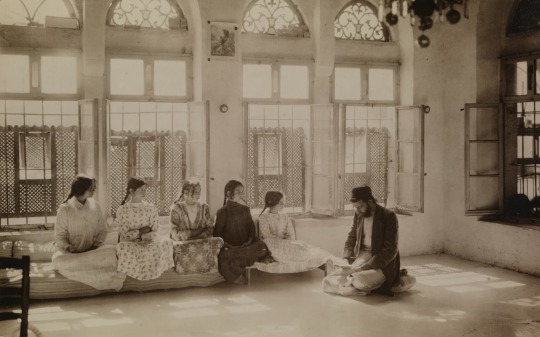
Girls learn ancient Hebrew in Samaria, a region in modern day Palestine 🇵🇸, in the early 1900s. Photograph By American Colony Photographers, National Geographic Image Collection
Hebrew Never Really Died
The Jewish people were once known as Hebrews for their language, which flourished from roughly the 13th to second centuries B.C.—when the Hebrew Bible, also known as the Old Testament, was collected. Hebrew was used in daily life until the second century B.C. at latest, experts believe.
But beginning in the second century B.C., Jewish people became increasingly ostracized and oppressed. Through the rise and fall of Rome, the Middle Ages, Renaissance, and beyond, they were forced to migrate around Europe and adopted the language of the country they were in. They also formed new languages like Yiddish, which mixed Hebrew, German, and Slavic languages.
Still, the Jewish people were known as “People of the Book.” As part of traditions like studying the Torah and reading it aloud, Jews continued to learn Hebrew to read from the Bible and written Hebrew lived on for more than a millennium mostly through religious practice.
There were exceptions: more educated Jews exchanged messages in Hebrew, sometimes between merchants for records of business, says Meirav Reuveny, a Hebrew language historian at the Hebrew University of Jerusalem. A 10th-century trove of documents showed that some women, a group generally confined to domestic duties at the time, also wrote letters, exchanged legal documents, and recorded business in Hebrew. From the 10th to 14th centuries, there was an explosion of secular Hebrew poetry in Andalusia, Spain.
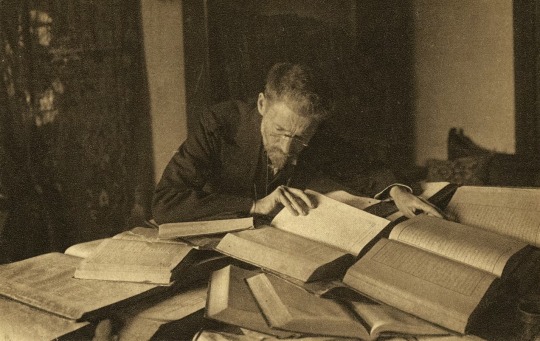
Eliezer Ben-Yehuda reads at his desk shortly before his death in 1922. Historian Cecil Roth famously said, “Before Ben‑Yehuda, Jews could speak Hebrew; after him, they did.” Photograph By Lebrecht Music & Arts, Alamy Stock Photo
Waking The Giant
In the 19th century, most Jews in Europe were still second-class citizens when a new movement emerged that looked to Hebrew as a way to inspire hope through the Jewish people’s glorious past, Reuveny says. Hebrew revivalists wanted to expand the language beyond the abstract concepts in the Bible—they wanted to use it to talk about modern events, politics, philosophy, and medicine.
Among the leaders of the movement was Eliezer Ben-Yehuda, credited as the father of Modern Hebrew.
“One person cannot invent a language,” Reuveny says. “But he makes a good hero, something important for a social movement.”
Ben-Yehuda was born in 1858 in Lithuania, where Jews were heavily discriminated against and violent pogroms terrorized Jewish communities regularly. When Ben-Yehuda traveled to Paris in 1878, he was empowered by the growing Jewish nationalist movement he witnessed there.
He believed Jews needed a country and language to flourish. He moved to Jerusalem in 1881, where he and his wife made the decision to only speak Hebrew—despite missing words for essential modern items and concepts. They raised their son Itamar Ben-Avi to be the first native Hebrew speaker in almost 2,000 years.
In the beginning, Hebrew went through growing pains: the language needed many new words. Ben-Yehuda made a dictionary of new Hebrew words (including מילון, or milon, the word for dictionary). Hebrew newspapers across Europe invented their own words, too, Reuveny says.
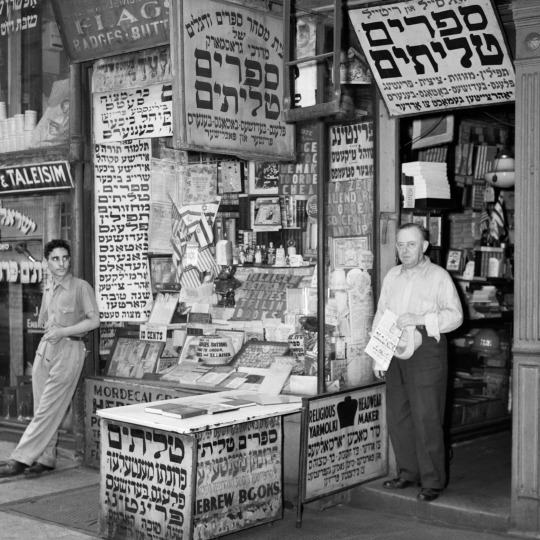

Left: A shop on New York City’s Lower East Side in 1940 is covered with signs written in Yiddish, which primarily uses the Hebrew alphabet. Photograph By Charles Phelps Cushing, Classicstock/Getty Images
Right: A boy learns the Hebrew alphabet as a member of a Black Jewish congregation in the Harlem neighborhood of New York City, circa 1955. Photograph By Archive Photos, Getty Images
Many people saw this as an unwelcome change—swapping an ancient and sacred language to a new and strange one. Hebrew revivalists chose a difficult way of life by speaking only Hebrew, before it could meet the needs of modern life.
Gradually, the language was standardized in the early 20th century. The first Modern Hebrew dictionary was released in its completed form in 1922. Hebrew language schools were opened, then Hebrew became the language of instruction of all subjects in Jerusalem schools (the first in 1913).
After the state of Israel was established in 1948, people flocked from all over the world. Many young adults learned Hebrew through the young nation’s mandatory military service, though most families in Israel became Hebrew speakers over one to two generations.
Today, of the 9.5 million people in Israel aged 20 and over, almost everyone uses Hebrew, and 55 percent speak it as their native language. Around the world there are around 15 million Hebrew speakers; in the U.S., there are 195,375.
An Unstoppable Force
Modern Hebrew has changed significantly but still shares clear ties with Biblical Hebrew.
“King David and I could probably understand each other,” says Mirit Bessire, Hebrew language program director at Johns Hopkins University, who points out that it’s not all that different from modern English speakers attempting to understand someone using Shakespearean English.
The growing pains Hebrew experienced as it modernized during Ben-Yehuda’s time are echoed in controversies today. Inclusive language such as non-binary adaptations have proven difficult to adopt as Hebrew is significantly gendered, Reuveny says. Modern words and concepts like “gaslighting” also stir debate about how much outside cultures are affecting the language.
“Language does naturally evolve and grow. It’s inevitable. It’s not in our hands what our language does,” Bessire says.
Language fills the needs of its users, she adds—and today we have more needs than ever as social media and email connect communities of Hebrew speakers far beyond Israel. For example, Bessire says, there are Hebrew communities in China that are not Jewish but have become fluent in the language for business purposes.
“Hebrew is a language of proficiency,” Bessire says. “It's a language that you use for your everyday life, from technology to medicine.”
3 notes
·
View notes
Photo



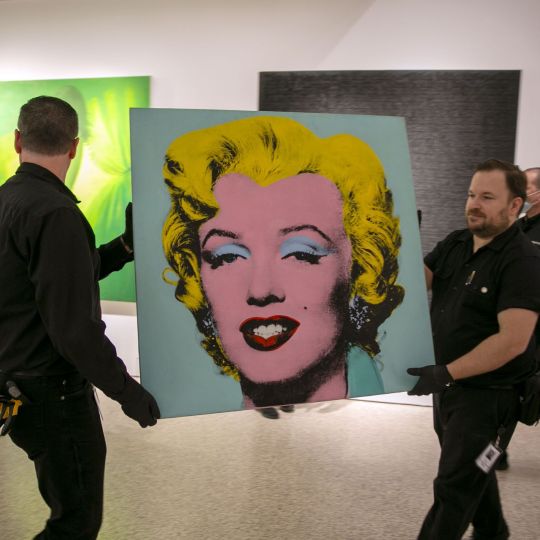


Andy Warhol's 1964 Portrait of Marilyn Monroe Sells a $195 Million
One of Andy Warhol's iconic Marilyn Monroe portraits has become the most expensive 20th-century artwork ever to go under the hammer.
The 40-square-inch "Shot Sage Blue Marilyn," one of dozens of images the artist made of Monroe in the 1960s, sold for a record $195 million at Christie's in New York Monday evening.
Prior to the sale, Christie's had described "Shot Sage Blue Marilyn" as "one of the rarest and most transcendent images in existence." It has previously been shown at galleries including the Guggenheim Museum in New York, the Centre Pompidou in Paris and London's Tate Modern.
The auction house had initially said it was expecting bids "in the region of" $200 million.
Warhol's colorful reproductions of Monroe's photo portrait -- originally a publicity still from her 1953 movie "Niagara" -- are among his most recognizable works, alongside his signature paintings of Campbell's soup cans.
Using a technique called silkscreen printing, which duplicates images on paper or canvas using a layer of fine-mesh silk like a stencil, he began creating them in 1962, shortly after Monroe's death. As with his depictions of other famous figures, including Elvis Presley and Chinese leader Mao Zedong, the Pop artist created numerous versions of Monroe's portrait in various different colors and configurations.
Among the best-known is "Marilyn Diptych," owned by British gallery group Tate, which saw Warhol print a grid of 50 portraits across two canvases. Elsewhere, the Museum of Modern Art's "Gold Marilyn Monroe" features a single image printed against a gold background, while "Shot Marilyns" saw the artist shooting portraits of the star through the head with bullets.
In 1964, he developed a "more refined and time-intensive" new process that was "antithetical to the mass production he was best known for," according to Christie's. That year, he used it to create a limited number of portraits -- a rare group of works to which "Shot Sage Blue Marilyn" belongs -- before abandoning the technique.
While a handful of paintings are thought to have attracted price tags in excess of $200 million in private sales (including works by the Abstract Expressionist painters Willem de Kooning and Jackson Pollock), the feat has only once been achieved at auction -- by Leonardo da Vinci's "Salvator Mundi," which in 2017 sold for over $450 million. The previous auction record for a 20th-century painting was the $179.4 million paid for Pablo Picasso's "Les Femmes d'Alger (Version O)" in 2015.
The auction record for a Warhol work was previously held by "Silver Car Crash (Double Disaster)," which depicts the mangled aftermath of a road collision and sold for more than $105 million almost a decade ago. Several of the artist's other Marilyn images have also attracted huge sum at auction in recent years, with 1962's "White Marilyn" selling for $41 million in New York in 2014.
"Shot Sage Blue Marilyn," meanwhile, was owned by a succession of high-profile gallerists and collectors before being purchased by the late Swiss art dealer Thomas Ammann. The portrait was offered for auction by the Thomas and Doris Ammann Foundation Zurich, the charitable organization set up in his (and his sister's) name, which will use the proceeds to fund health and education programs for children worldwide, according to a press release.
n a press statement prior to the sale, Christie's chairman of 20th and 21st century art, Alex Rotter, described the work as "the absolute pinnacle of American Pop" and "the most significant 20th century painting to come to auction in a generation."
"Standing alongside Botticelli's 'Birth of Venus,' Da Vinci's 'Mona Lisa' and Picasso's 'Les Demoiselles d'Avignon,' Warhol's 'Marilyn' is categorically one of the greatest paintings of all time," he added.
The artwork was one of four Warhols in the Ammanns' collection on sale at Monday evening's auction. One of his famous "Flowers" silkscreen paintings went for $15.8 million, and "GE/Skull," which he created in collaboration with the late Jean-Michel Basquiat, fetched over $4.6 million. Warhol's sculpture "Heinz Tomato Ketchup Box" meanwhile sold for more than $478,000.
Elsewhere, works by Robert Ryman, Alberto Giacometti and Lucian Freud also went under the hammer. Two of the biggest sellers were paintings by American artist Cy Twombly, "Untitled" and "Venere Sopra Gaeta," which fetched $21 million and almost $17 million respectively.
#Andy Warhol's 1964 Portrait of Marilyn Monroe Sells a $195 Million#Shot Sage Blue Marilyn#American artist film director and producer#art#artist#art work#art news#luxury#luxury goods#luxury living#luxury lifestyle#billionaire#billionaire lifestyle#Christie's#painting#auction#marilyn monroe
28 notes
·
View notes
Text
FLAGSTAFF, Ariz. (AP) — Federal penalties have increased under a newly signed law intended to protect the cultural patrimony of Native American tribes, immediately making some crimes a felony and doubling the prison time for anyone convicted of multiple offenses.
President Joe Biden signed the Safeguard Tribal Objects of Patrimony Act on Dec. 21, a bill that had been introduced since 2016. Along with stiffer penalties, it prohibits the export of sacred Native American items from the U.S. and creates a certification process to distinguish art from sacred items.
The effort largely was inspired by pueblo tribes in New Mexico and Arizona who repeatedly saw sacred objects up for auction in France. Tribal leaders issued passionate pleas for the return of the items but were met with resistance and the reality that the U.S. had no mechanism to prevent the items from leaving the country.
“The STOP Act is really born out of that problem and hearing it over and over,” said attorney Katie Klass, who represents Acoma Pueblo on the matter and is a citizen of the Wyandotte Nation of Oklahoma. “It's really designed to link existing domestic laws that protect tribal cultural heritage with an existing international mechanism.”
The law creates an export certification system that would help clarify whether items were created as art and provides a path for the voluntary return of items that are part of a tribe's cultural heritage. Federal agencies would work with Native Americans, Alaska Natives and Native Hawaiians to outline what items should not leave the U.S. and to seek items back.
Information provided by tribes about those items would be shielded from public records laws.
While dealers and collectors often see the items as art to be displayed and preserved, tribes view the objects as living beings held in community, said Brian Vallo, a consultant on repatriation.
“These items remain sacred, they will never lose their significance,” said Vallo, a former governor of Acoma Pueblo in New Mexico. “They will never lose their power and place as a cultural item. And it is for this reason that we are so concerned."
Tribes have seen some wins over the years:
— In 2019, Finland agreed to return ancestral remains of Native American tribes that once called the cliffs of Mesa Verde National Park in southern Colorado home. The remains and artifacts were unearthed by a Swedish researcher in 1891 and held in the collection of the national Museum of Finland.
— That same year, a ceremonial shield that vanished from Acoma Pueblo in the 1970s was returned to the tribe after a nearly four-year campaign involving U.S. senators, diplomats and prosecutors. The circular, colorful shield featuring the face of a Kachina, or ancestral spirit, had been held at a Paris auction house.
— In 2014, the Navajo Nation sent its vice president to Paris to bid on items believed to be used in wintertime healing ceremonies after diplomacy and a plea to return the items failed. The tribe secured several items, spending $9,000.
—In 2013, the Annenberg Foundation quietly bought nearly two dozen ceremonial items at an auction in Paris and later returned them to the Hopi, the San Carlos Apache and the White Mountain Apache tribes in Arizona. The tribes said the items invoke the spirit of their ancestors and were taken in the late 19th and 20th centuries.
The STOP Act ties in with the Native American Graves Protection and Repatriation Act that requires museums and universities that receive federal funds to disclose Native American items in their possession, inventory them, and notify and transfer those items to affiliated tribes and Native Hawaiians or descendants.
The Interior Department has proposed a number of changes to strengthen NAGPRA and is taking public comment on them until mid-January.
The STOP Act increases penalties for illegally trafficking Native American human remains from one year to a year and a day, thus making it a felony on the first offense. Trafficking cultural items as outlined in NAGPRA remains a misdemeanor on the first offense. Penalties for subsequent offenses for both increase from five years to 10 years.
New Mexico U.S. Rep. Teresa Leger Fernandez, who introduced the House bill, said time will tell whether the penalties are adequate.
[...]
5 notes
·
View notes
Photo

✨💫Sweater:Sparks Wide Plaid Mohair Sweater by Sandro🌺🧚♀️ Worn on:Emily in Paris episode "An American Auction in Paris" - 1x09Worn by:Emily Cooper played by Lily Collins ❤ #emilyinparis #emilyinparisoutfit #emilyinparisseason1 #emilyinparis1x09 #emilycooper #emilycooperstyle #emilycooperoutfits #lilycollins #lilycollinsstyle #sandro #sandrostyle https://www.instagram.com/p/Cl6jo_dIAIT/?igshid=NGJjMDIxMWI=
#emilyinparis#emilyinparisoutfit#emilyinparisseason1#emilyinparis1x09#emilycooper#emilycooperstyle#emilycooperoutfits#lilycollins#lilycollinsstyle#sandro#sandrostyle
3 notes
·
View notes
Text
Typhon’s Beginnings
So for the Typhonverse, we probably should get into who exactly our villain is. While Typhon won’t be the main character, (I don’t really know how to write or want to write a villain protagonist), he is at the center of this world. The story begins with him finding the Peacock and deciding how he wants to wield it and it will end with his eventual defeat and punishment. Hopefully. We’ll see how things go. ;)
But first, we need to look at how this universe differs from the original world. From what I understand, everything started with ML episode Feast, where the character Fu ended up losing the Butterfly and Peacock Miraculouses as well as the Miraculous Spellbook, though he managed to hang onto the one remaining Miraculous box as the temple was destroyed. This was why he was the one to give the Ladybug and Black Cat miraculouses to Marinette and Adrien respectively.
This is fine, but there are a few things I need to change. For one, I don’t want this story to take place in Paris. For one, I know nothing about Paris as I’m American and have never left the country. It also would make it too easy to draw the original cast into the story, which is something I don’t want. Another thing is that I don’t want Fu to be handing out the miraculouses. It wouldn’t work for the story I have in mind.
So let’s go with this. Most of that original story can stay, up to Fu getting the book and the box. But instead of just losing the two miraculouses, he ends up losing all of them and only hanging onto the book and the box. This means that the miraculouses are lost and end up scattered around the world, and Fu is the only remaining person who can get them back. So Fu does just that, traveling the world and collecting miraculouses as he finds them, maybe even getting in fights with users who don’t want to give up the power.
Cut to let’s say...two years from the present day. James Kinsley, the man who will become Typhon, wanders into an auction and sees a peacock brooch being auctioned off. Being a man of some means, he buys it on a whim. He goes home, locks himself in his office, and tries on the brooch. To his surprise, Duusu pops out, thrilled to have a wielder again after many years.
Kinsley is a clever man, so he asks Duusu for all the information about himself and kwamis and miraculouses, and Duusu is all too happy to tell, even if he didn’t have to obey his wielder’s commands. So Kinsley learns all about Duusu’s powers, all about sentibeings, and how they have to obey the person holding their amok.
James Kinsley’s job boils down to professional coorperate spy. Large companies and wealthy individuals hire him to systematically and silently take down rivals. Small businesses that refuse to sell end up suddenly accused of tax fraud and are shut down, forcing them to sell their land off at a loss. A rising business man or woman is plagued by harassment and false videos, with bosses quietly firing them so others can take their place. Kinsley is very good at what he does. But with sentimonsters at his fingertips, he could be even better.
But he needs to test his theory, needs to make sure that Duusu is telling the truth and that the sentimonsters he creates won’t turn on him. Kinsley is paranoid about control, which is part of what makes him good at his job. So he summons the one person he knows won’t disobey him to his office. His fourteen year old daughter, Andromeda. (Kinsley is also a huge astronomy and Greek mythology nerd.)
Kinsley transforms for the first time and demands that Andromeda help him create a sentimonster. Already terrified of her father, she agrees and between the two, they are able to create Typhon’s first sentimonster. One who looks remarkably human, the spitting image of Andromeda herself. Kinsley is thrilled with this as he wants the most humanlike sentimonsters he can create for his plans.
That’s when his wife storms in. She’s already been working on divorcing her husband, as he’s verbally and emotionally abusive to her and Andromeda. Seeing the sentimonster, she quickly puts two and two together and attack him, knowing that Kinsley is the worst potential person to give superpowers. As she tries to rip the miraculous off, Kinsley grabs a knife letter opener from his desk and cuts her throat. She bleeds out quickly.
Andromeda turns to flee, but Kinsley immediately goes after her and kills her too. The sentimonster silently watches, eyes full of terror as Kinsley transforms once more and creates a new sentimonster. A sluglike creature that devours the bodies and destroys any potential evidence of their deaths. No human alive now knows about his power.
Typhon destroys the slug monster and turns to the sentibeing wearing his daughter’s face. He gives her his first command, that she never betray him. With no choice, as he now holds her amok, she bows her head in ascent. Typhon smiles, plans already forming in his mind. He will soon have all the power and wealth he ever dreamed of, and no one will stop him.
After all, no one knows who he is.
2 notes
·
View notes